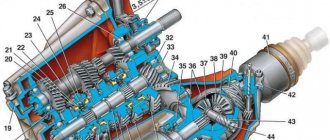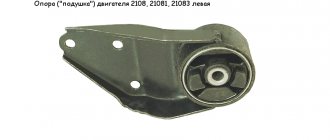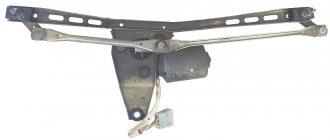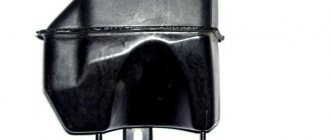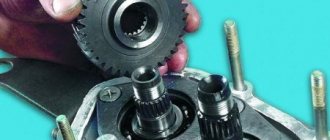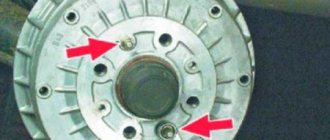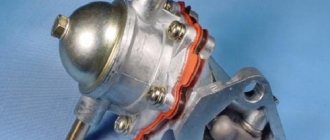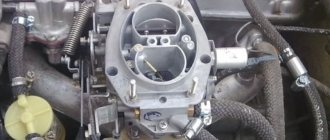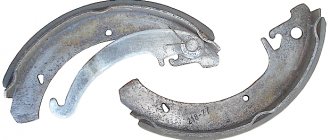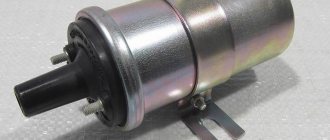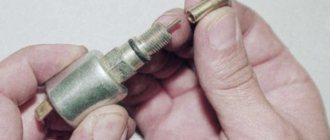The VAZ 2109 tank is located under the bottom of the car, under the rear seat
The gas tank on a VAZ 2109 is replaced if it is broken. Or if a fuel leak appears at the junction (in this case, you can try to solder it). The appearance of a leak as a result of destruction of the walls of the tank is treated by replacing it. When the fuel line on a VAZ 2109 becomes clogged, removing the gas tank and cleaning it solves this problem, and the grid of the electric fuel pump should be replaced. Each car owner can carry out the replacement independently if necessary. Don’t even think about succumbing to advertising that offers to buy Super, an additive that, when poured into the tank, leads to complete resorption of dirt. Know that this method is only good as a preventive measure, for example, every 10,000 kilometers you fill in a similar product, then it really helps to remove sediments and deposits not only from the gas tank, but also cleans the entire fuel line without any damage to your car. In the case (and such cases are common among car owners) when the gas tank on a VAZ 2109 has never been cleaned before, the use of an additive will only complicate the problem.
↑ Fuel tank elements
1 — air release hose; 2 — separator hose; 3 - filling pipe hose
First, disconnect the wire from the “–” terminal of the battery.
NOTE! It is recommended to have an assistant remove the fuel tank.
- Fold back the rear seat cushion and unscrew the cut-out part of the sound insulation.
- Unscrew the two screws securing the hatch cover.
- Remove the hatch cover with the rubber gasket.
- Disconnect the block with wires from the fuel level sensor.
- Unscrew the nut securing the sensor, under which the ground wire is secured.
- Remove the wire from the stud.
The remaining operations are carried out under the bottom of the car.
↑ Clamps and hoses
- Loosen the clamp.
- Disconnect the hose from the filler pipe.
- Loosen the clamp and disconnect the air release hose from the fitting on the fuel tank.
- Loosen the clamp and disconnect the separator hose from the fitting on the fuel tank.
- Loosen the clamps and disconnect the hoses from the fuel lines.
- Holding the tank, unscrew the two bolts of the tank mounting clamps.
- Pull the clamps down while supporting the tank. Bend the clamp on the left side behind the resonator pipe.
↑ Removing the fuel tank from the car
- Lower the front end of the tank down and remove it from the vehicle. Drain any remaining gasoline from the tank.
- Unscrew the five remaining sensor mounting nuts and remove the fuel gauge sensor from the tank.
- Remove the sensor gasket.
↑ Diagnostics and repair of the fuel tank
- Inspect the tank along the line where the upper and lower parts meet.
- If you find a leak, pour out the remaining gasoline, thoroughly rinse and dry the tank. Then solder the leak with soft solder.
- If necessary, glue the torn rubber gaskets on the tank.
Warnings!
You can solder only a thoroughly washed tank that does not contain gasoline vapors. Otherwise, when soldering, the vapors may ignite.To wash the fuel tank, use detergents: “Labomid”, “MS” or “ML”.
To remove any remaining detergent, rinse and steam the tank with hot water. Dry the tank thoroughly.
↑ Checking the sensor
Connect an ohmmeter to the sensor contacts and check the sensor resistance at three float positions:
- in the lowest position (empty tank) the resistance should be 315 - 345 Ohms,
- in the middle position (tank half full) – 108–128 Ohm,
- in the uppermost position (full tank) – no more than 7 Ohms.
If the resistance is different from the specified value, replace the sensor.
↑ Filter and float
Wash the dirty filter. Shake the float. If there is gasoline in it, then the float is leaking. We recommend replacing the float.
↑ Replacing fastening clamps
To replace the tank mounting clamps, remove them from the brackets on the body and install new ones.
Basic gas tank malfunctions
The gas tank is made of strong, durable material and lasts for the entire life of the vehicle. However, in some situations it may require repair. These situations are as follows.
Fuel line clogged.
Hole in the tank.
Leak on the welding line of the tank body.
The cause of clogged hoses can be dirt getting into the fuel mesh in the tank itself. The solution in this case is quite simple - periodically wash or change this mesh.
If a hole is formed in the tank as a result of a mechanical shock, then it can no longer be repaired. In this case, the tank will need to be replaced.
If gasoline leaks from the welding line of the tank halves, you can try to seal this place. However, this procedure is very complex and requires appropriate experience.
A gas tank with extensive corrosion cannot be repaired.
Checking the general condition of the fuel pump
First of all, let’s check whether the supply system of your VAZ 2109 is working at all. To do this, you need to take the following steps:
- Remove the pump fuel hose from the source or discharge fitting;
- Manually press the fuel pump lever several times;
- If the pump is operational, a strong stream of fuel will immediately flow through the fitting;
- If there is no jet or it is very weak, it will be necessary to carry out other checks.
Intake Valve Check
- Disconnect the hose from the suction fitting so that both hoses are eventually removed, each from its own fitting.
- Simply plug the suction fitting with your finger, then pull the lever several times to manually pump fuel. If everything works fine, your finger will begin to be sucked into the fitting. This effect indicates that the pump is working properly. Therefore, we look for the problem in the tank or lines.
- If there is no suction, you will have to disassemble the device to replace the inlet valve. Its tightness is most likely broken.
Leak test
To check the tightness of the intake valve, you must:
- Place your finger on the hole from the injection fitting and pump up the fuel several times using manual pumping;
- In this case, a stream of air should come out of the hole, significantly repelling the pressed finger;
- If the stream turns out to be weak or does not exist, the fuel pump simply does not pump.
In this situation, there are two options - look for the problem inside the fuel pump device, disassembling the pump, or change the entire unit.
The filter is clogged or damaged
To fix the situation, you need:
- Remove the cover from the fuel pump, remove the filter, clean and rinse it with clean fuel. Then be sure to blow out with compressed air;
- Check the condition of the filter. If it is deformed, no repair will help. You will have to change the filter device;
- If you have a Pekar pump or a similar one, the filter can be removed by unscrewing the suction fitting from the cover. That is, it is not necessary to remove the cover at all.
Pump diaphragm failure
You need to do the following for your fuel pump:
- Remove the upper part of the fuel pump housing and remove the diaphragm assembly from there;
- Unscrew the nut on the rod, and then pull out the 3 diaphragms;
- Replace faulty elements with new ones. They are available in any repair kit for the VAZ 2109 fuel pump;
- Reassemble the assembly in reverse order;
- If you have a Pekar pump, there is only one diaphragm. It can be removed by removing the cover;
- To disconnect the diaphragm assembly, rotate it 90 degrees.
Be sure to simultaneously check the condition of the spring located under the diaphragm. To do this, you need to remove the upper part of the pump housing, remove the diaphragm rod and look at the current state of the spring. If it is broken, deformed or lacks elasticity, replace the element.
Node elements
Intake and exhaust valve malfunctions
If both valves raise doubts about their functionality, certain measures will have to be taken.
- Remove the cap from the fuel pump and remove the strainer.
- Visually assess the condition of the pump cavity and inlet valve.
- With the top of the pump body removed, you can take a look at the outlet valve.
- If both valves are not installed tightly enough, they are not pressed well or have become motionless, replace the entire pump completely.
- If you find traces of clogged valves, remove them and blow out the housing with compressed air.
In the case of the Pekar pump, two valves are located in the cover, so to assess their condition, simply remove the cover from the fuel pump housing.
Damage to the pusher
It is not uncommon for a fuel pump to fail to operate due to damage to the pusher. We have prepared separate instructions for this case.
- Remove the pump from the studs by unscrewing the fastening nuts. The thermal insulation insert, pusher and gaskets remain on the motor.
- Rotate the crankshaft to extend the pushrod as far as possible.
- Measure the distance that the pusher protrudes relative to the top gasket. Normally, the figure is 0.8-1.3 millimeters.
- If the protrusion is smaller or larger, try adjusting it using thicker or thinner shims.
- Between the thermal insulation insert and the pump there is an external gasket with the greatest thickness. It is this that needs to be changed when adjusting the protrusion.
- New gaskets are available in repair kits, although many make their own. To do this you will need a piece of paronite.
Power supply system VAZ 21099 Lada Samara
11.3.1 Power system Warning When removing and disassembling the carburetor, do not smoke or use open flame! PERFORMANCE ORDER 1. Disconnect the choke rod. 2. Remove the accelerator drive return spring. 3. Remove the spring clamp on the accelerator drive sector by prying its hole... 11.3.2 Removing and installing the carburetor Warning When removing and disassembling the carburetor, do not smoke or use open fire! PERFORMANCE ORDER 1. Disconnect the choke rod. 2. Remove the accelerator drive return spring. 3. Remove the spring clip on the accelerator drive sector by prying its hole...
11.3.3 Disassembling the carburetor Carburetor (left view): 1 - air damper 2 - starting device 3 - mixture quantity adjustment sensor-screw 4 - accelerator pump 5 - solenoid valve 6 - carburetor cover Carburetor (right view): 1 - first chamber 2 - second chamber 3 - accelerator spray...
11.3.4 Defective carburetor parts Wash the carburetor filter in gasoline and blow with compressed air. Warnings If the floats are incorrectly positioned, the operation of the carburetor will be disrupted. Therefore, be sure to check the installation of the floats according to the template (see “Adjusting the fuel level in the float chamber”). Don't clean...
11.3.5 Assembling the carburetor Notes The marking of the jets is determined by the flow rate, which is measured using micrometers. Micrometers are adjusted using standard jets. The conditional flow rate of the fuel jet is determined by the reference jet using a special method. Control during operation...
11.3.6 Adjusting the air damper actuator Before you begin: remove the air filter. Fully open damper. PERFORMANCE ORDER 1. Loosen the bolt securing the linkage to the air damper drive lever. 2. Turn the choke lever until it is fully open. 3. Recess the handle completely...
11.3.7 Adjusting the throttle valve drive Note When tightening nut 1, the valve opens, and when tightening nut 2, the valve closes. PERFORMANCE ORDER 1. Press the accelerator pedal all the way. In this case, the throttle valve of the first chamber should open completely. This can be determined by...
11.3.8 Adjusting the engine idle speed Warnings Idle speed adjustment is performed on a warm engine (coolant temperature 90–95 °C) with adjusted clearances in the valve drive and correctly set ignition timing. The air damper must be completely open. Since the adjustment...
11.3.9 Adjusting the starting device Adjusting the starting device is carried out with the carburetor removed. Before making adjustments, check the condition of the trigger diaphragm by unscrewing the four screws and removing the cover. Replace the defective diaphragm. Starting clearances, mm: carburetor 21081–1107010: air damper other...
Replacing the VAZ 2109 gas tank if necessary
The VAZ 2109 tank is located under the bottom of the car, under the rear seat
The gas tank on a VAZ 2109 is replaced if it is broken. Or if a fuel leak appears at the junction (in this case, you can try to solder it). The appearance of a leak as a result of destruction of the walls of the tank is treated by replacing it. When the fuel line on a VAZ 2109 becomes clogged, removing the gas tank and cleaning it solves this problem, and the grid of the electric fuel pump should be replaced. Each car owner can carry out the replacement independently if necessary. Don’t even think about succumbing to advertising that offers to buy Super, an additive that, when poured into the tank, leads to complete resorption of dirt. Know that this method is only good as a preventive measure, for example, every 10,000 kilometers you fill in a similar product, then it really helps to remove sediments and deposits not only from the gas tank, but also cleans the entire fuel line without any damage to your car. In the case (and such cases are common among car owners) when the gas tank on a VAZ 2109 has never been cleaned before, the use of an additive will only complicate the problem.
Design and location of the gas tank VAZ 2108/09/14/15
A gas tank is one of the elements of a car's fuel system. Its main and only purpose is to store a certain amount of fuel. In this case, storage is carried out as safely as possible, without leaks and fumes.
On VAZ 2108/09/14/15 cars the fuel tank is installed under the rear seat. Therefore, even in the event of a serious head-on collision, its damage will be minimal. The risk of fuel leakage and ignition will be equally minimal.
The tank volume on VAZs is 43 liters (including a reserve of 4–6 liters). This volume should be enough for the car to run autonomously for 400–600 kilometers.
The fuel tank on the VAZ 2108/09/14/15 is located under the rear seat
How to remove the gas tank on a VAZ 2107, 2109, 2110
Fuel level sensor FLS for VAZ 2108, 2109, 21099 cars
How to remove the gas tank?
Almost all drivers who have owned a car for five years or more eventually wonder how to remove the gas tank. There may be several reasons for this need. For example, changing the gas pump or gas intake filter, cleaning the old tank or replacing it with a new one. In principle, there is nothing tricky or complicated in this task, except for minor differences in mounting the gas tank on different cars. On domestic VAZ 2110, 2109 it is installed at the bottom, on the VAZ 2106 or 2107 on the side, and on foreign cars again at the bottom. In general, different locations have their own operating nuances in each individual case, although sometimes there is no need to remove the fuel tank if you just need to clean the fuel system, of which this tank is a part.
Most often, removal is required after an accident, during body work, or to replace it with a new one, when the old tank is so rotten that it makes no sense to seal all the holes and cracks, it’s easier to buy and install a new one, it will be even cheaper. But one thing can be said for sure, in relation to any make and model of car - the gas tank, as well as the entire fuel system of the car, must be carefully monitored, periodically subjecting it to various preventive maintenance work. We must not lose sight of the change of seasons, when during the transitional spring-autumn period the tank needs to be cleaned and washed.
Procedure for removing the fuel tank
We will not focus on either domestic cars or foreign cars, so as not to mislead anyone, but we will trace the entire principle of operation point by point, so that everyone can understand how to remove the gas tank on almost any car.
To avoid any failures, you need to strictly follow the removal order, then the entire tank replacement will be successful. That, in fact, is the whole task. As you can see, there is nothing extremely complicated or difficult about this.
Some tips and tricks
- If you constantly use your car, then you do not need any regular replacements - you just need to clean the fuel tank every three years, draining the settled gasoline and rinsing it (the tank) clean. Remember that gasoline is not a pure fuel, but a hydrocarbon mixture containing water, which, when the car is parked for a long time, begins to separate from the coal part. If this happens in winter, then condensation easily forms in the tank, turning into very light ice. To prevent a thin crust of ice from forming in the tank when the car is parked for a long time, you need to keep it at least half full.
- Of course, before removing the tank, you need to pump out the remaining fuel from it. This is especially true for leaded steel gas tanks. This is done simply, using an ordinary rubber hose that fits the diameter of the hatch hole.
- When removing the tank for repairs and patching holes, it must be very well cleaned, rinsed and dried. Gasoline is a flammable substance and there should be no open fire nearby.
- If fuel begins to leak from your car’s tank while on the road, you can temporarily plug the hole that appears with regular fatty soap. Gasoline does not react with it and does not dissolve, which will give you the opportunity to hold out at least until the nearest workshop.
Fuel tank volume Lada Vesta
Another example for 2112.
Replacing a filter on a carburetor car
In order for the replacement of the fuel filter on a carburetor VAZ 2109 to be successful, it is recommended to follow the step-by-step instructions presented below.
- There is no high pressure in the fuel circuit of a carburetor car, so there is no need to bleed gasoline.
- Open the hood.
- Unscrew the clamps at the ends of the filter.
- Disconnect one of the hoses.
- Drain the fuel from the filter.
- Disconnect the second tube and remove the filter from the engine compartment.
- Install a new filter, taking into account the direction of gasoline flow.
- Check for fuel leaks while the engine is running.
vote
Article rating
Fuel lines and fine fuel filter
Fuel lines 35 and 36 are made of leaded or galvanized steel tubes. The tubes are connected to the fuel pump and to the tank by rubber hoses in a fabric braid and secured with screw clamps. The fuel pump is connected to the carburetor by a rubber hose.
The fuel supply line 35 is made with a diameter of 8 mm, the drain line 36 with a diameter of 6 mm. In front of the fuel pump 32, a fine fuel filter 33 is installed on the hoses and secured to the hoses with screw clamps. The filter has a non-separable design with a paper filter element in a plastic housing. The plastic body and lid are welded using ultrasonic welding or high-frequency currents.
Source
Basic gas tank malfunctions
The gas tank is made of strong, durable material and lasts for the entire life of the vehicle. However, in some situations it may require repair. These situations are as follows.
Fuel line clogged.
Hole in the tank.
Leak on the welding line of the tank body.
The cause of clogged hoses can be dirt getting into the fuel mesh in the tank itself. The solution in this case is quite simple - periodically wash or change this mesh.
If a hole is formed in the tank as a result of a mechanical shock, then it can no longer be repaired. In this case, the tank will need to be replaced.
If gasoline leaks from the welding line of the tank halves, you can try to seal this place. However, this procedure is very complex and requires appropriate experience.
A gas tank with extensive corrosion cannot be repaired.
Description of design
The fuel supply is located in the tank located under the bottom in the rear seat area. The tank is made of steel and consists of two stamped parts welded together. The tank is connected through a drain hose to a separator that captures gasoline vapors. The condensate from the separator is drained back into the tank. The separator communicates with the atmosphere through a two-way valve that prevents excessive increase or decrease in pressure in the fuel tank. The filler neck is connected to the tank with a gas-resistant rubber hose secured with clamps. The plug is sealed.
Actual tank volume on the 14th model
As mentioned, the manufacturer claims that the volume of the 2114 tank is 43 liters (in some cases you can find a figure of 42.5 liters). And this figure is indeed very close to reality.
At the same time, it is worth considering a number of facts that can significantly affect capacity:
- Errors in the manufacture of the tank.
- Time of year and temperature.
- Fuel system volume.
The first of these factors is usually insignificant. But, as practice shows, sometimes the difference in the volumes of two identical tanks can reach (as a result of low production accuracy) 2 liters. Thus, on some machines the total volume can reach 45 liters (which is extremely rare).
This should also include the difference in weather conditions. In cold weather, the fuel contracts, and in warm weather, it expands. This factor also affects how many liters the tank on a VAZ 2114 can hold (if we take into account the full volume of gasoline that can fit in hot summers and winter frosts, the difference can reach 1.5 liters).
What is a gas tank and what is it for?
The tank capacity of a modern car allows the driver to travel more than five hundred kilometers without refueling. It's time to figure out what this much-needed and important unit of the fuel system is:
- The fuel tank is a special container for safely storing fuel, preventing its leakage and losses due to evaporation
- Installed in the safest place on the machine
- The VAZ 2109 gasoline tank is located under the rear seat, since this area is least susceptible to deformation upon impact.
- The gas tank is attached to the car body with tape clamps
- To provide it with additional protection from damage, it can be protected from the bottom with a metal sheet
- To avoid fuel heating from exhaust system parts, it has thermal insulating gaskets
Tank material
In the manufacture of tanks, three main materials are used: plastic (polyethylene, the most modern material), aluminum and steel:
- Plastic, as the most modern one, is often used in the production of gas tanks for passenger cars.
- Plastic is convenient because it allows you to more fully use the entire installation space, make a container of almost any shape and size, and obtain the largest fuel capacity, which is most important.
- The main advantage of plastic is its resistance to corrosion.
- However, plastic is permeable to hydrocarbons at the molecular level, therefore, to avoid micro-leakage, the walls are made multilayer and the inner surface is additionally coated with fluorine
- Metal tanks are made by welding stamped steel sheets
- Aluminum is used mainly for diesel fuel, less often for gasoline.
